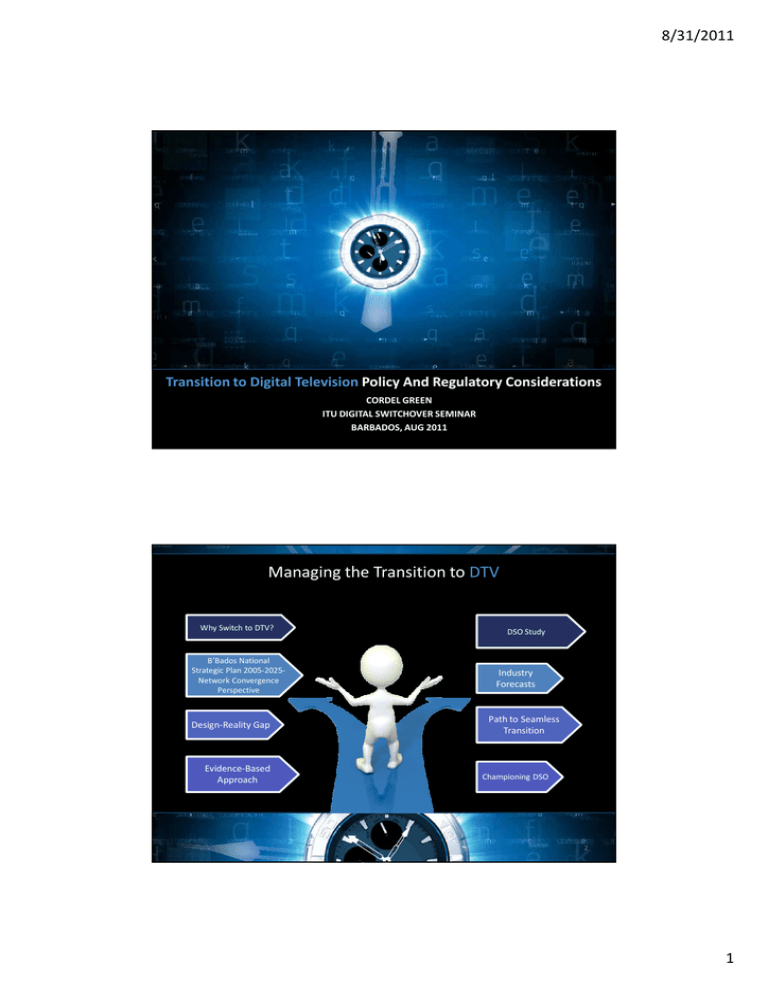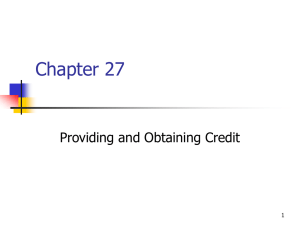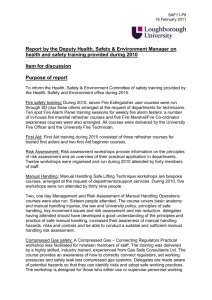Managing the Transition to DTV 8/31/2011 Transition to Digital Television
advertisement

8/31/2011 Transition to Digital Television Policy And Regulatory Considerations CORDEL GREEN ITU DIGITAL SWITCHOVER SEMINAR BARBADOS, AUG 2011 Managing the Transition to DTV Why Switch to DTV? B’Bados National Strategic Plan 2005-2025Network Convergence Perspective Design-Reality Gap Evidence-Based Approach DSO Study Industry Forecasts Path to Seamless Transition Championing DSO 2 1 8/31/2011 Why Switch to DTV? B’Bados National Strategic Plan 2005-2025 -Network Convergence Perspective Design-Reality Gap Evidence-Based Approach Good for the region socioeconomically Enables network integration (production to consumption) Allows cross-platform distribution One 6MHz channel with multiple programmes 3 Why Switch to DTV? B’Bados National Strategic Plan 2005-2025 -Network Convergence Perspective Design-Reality Gap Evidence-Based Approach Improved picture quality Easily adapts with advanced features Enables more efficient use of the spectrum Richer, more enhanced media experience RELEVANT TO B’DOS NATIONAL DEVELOPMENT ? 4 2 8/31/2011 B’Bados National Strategic Plan 2005-2025 Network Convergence Perspective Design-Reality Gap Evidence-Based Approach “A fully developed society that is prosperous, socially just and globally competitive.” Not possible if we are technology laggards DSO Study Transforming business models, leveraging the convergence of telecoms, broadcasting and the Internet 5 Scheduled Transition Dates Migration Strategy Needs to be Created and Implemented In a Timely Manner 6 3 8/31/2011 ICT Strategic Plan for B’Bados 20102015: An efficient Network Island Network Convergence Perspective Design-Reality Gap Evidence-Based Approach DSO Study “Exploiting the Power of ICTs to Benefit all Barbadians and Improve the Quality of Life” “Transform Barbados into a major information, communications technologies and services hub within the region and international arena.” 7 ICT Strategic Plan for B’Bados 20102015: An efficient Network Island Network Convergence Perspective Design-Reality Gap Evidence-Based Approach DSO Study Goal 1- Develop an ICT literate society that enables Barbadians of all segments of society to participate fully in the information society. Goal 2- Utilize ICTs to encourage and promote a culture of innovation and entrepreneurship in Barbadian society. 8 4 8/31/2011 ICT Strategic Plan for B’Bados 20102015: An efficient Network Island Network Convergence Perspective Design-Reality Gap Goal 3- Ensure that ICTs are available to all Barbadians. Evidence-Based Approach Goal 4- Use ICTs to position Barbados as a competitive jurisdiction. DSO Study 9 ICT Strategic Plan for B’Bados 20102015: An efficient Network Island Network Convergence Perspective Design-Reality Gap ICT Focus Areas include: Evidence-Based Approach DSO Study Access/Connectivity Children and Youth Local Content Development ICT infrastructure 10 5 8/31/2011 BROADBAND “a central delivery mechanism for all new technologies, applications and services”. 2009 OECD Study 11 DEMAND FOR BROADBAND SERVICES driven by:: Fast growing popularity of smartphones and tablet PCs Insatiable demand for video content Collaboration, key plank of network economy Cloud Computing 12 6 8/31/2011 ICT Strategic Plan for B’Bados 2010-2015: An efficient Network Island DSO can: Facilitate wireless broadband Respond to insatiable demand for video content ‘Interactivity’ dovetails into the “collaborative” nature of the networked economy. 13 Design-Reality Gap Evidence-Based Approach ‘There can be a wide gap between “hard”/technology approach and reality of “soft”/human factors (Hard(Hard-Soft Gaps) ’ DSO Study Heeks 2003, p.5 Industry Forecasts 14 7 8/31/2011 Design-Reality Gap Closing the DesignDesign-Reality Gap: Step 1: Align DSO project requirements with existing reality reality. Step 2: Enlightened Access -innovation innovation and creation of digital products and services for global consumption(Babb consumption 2003, p.3). Step 3: What will ultimately empower and enrich the poor are “content and applications, not technology” (ADBI 2001, p.9). 15 Evidence-Based Approach DSO Study Industry Forecasts Path to Seamless Transition Championing DSO Enormous Costs and Risks of DSO REQUIRE EvidencedEvidenced-Based Approach: •Investment in new digital transmission technology •New production equipment to deliver new technical quality and features •Simulcasting Simulcasting// Digital technology trials during the transition period 16 8 8/31/2011 Evidence-Based Approach •Inadequate communication (internal and external) •Inadequately trained staff (e.g. customer service; aerial installers) •Unavailable funding or expensive sources of funding to cover costs •High receiver prices •slow customer taketake-up 17 DSO Study Industry Forecasts Understanding Key market factors: • Carrying capacity (rate of growth of traditional advertising/potential for growth from new services) Path to Seamless Transition • Model for recovery-market costs • Sharing the digital dividend Championing DSO 18 9 8/31/2011 Industry Forecasts Path to Seamless Transition DSO Study Understanding Key market factors: •Optimal number of providers vs. free planning (“survival of the fittest” market dynamics) Championing DSO • Take-up of the different platforms (new digital services-substitutes or addition? • Level of potential consumer interest in new channels, high definition and/or mobile TV • Consumer willingness to pay for new services and/or improved technical quality (expected adoption rate by end users). 19 Industry Forecasts Path to Seamless Transition DSO Study Understanding Key market factors: • Estimation of how many households are in danger of being directly deprived in respect of : Championing DSO -their main TV set; -secondary sets and recording equipment. 20 10 8/31/2011 Industry Forecasts Path to Seamless Transition DSO Study Understanding Key market factors: •Estimation of the value of released spectrum. Championing DSO •Cost points and options for funding •technology selection • access and usability by persons with disabilities and other vulnerable groups 21 Industry Forecasts: ITU Jamaica Seminar Path to Seamless Transition 1 • Growth in digital STV and IPTV market share up to 2018 • Estimated 30,840 households will need subsidy at a cost of US$1.73 M Championing DSO 2 3 • The cost of financing public broadcasting switchover estimated to be US$5M in 2011, increasing to US$40M in 2013, and declining to US$5M in 2015 22 11 8/31/2011 Industry Forecasts: ITU Jamaica Seminar Path to Seamless Transition Championing DSO • MPEG 4 will be the preferred video coding standard and not MPEG 2. 1 • ATSC will be the preferred transmission standard. 2 • Existing players will share transmission facilities but want opportunity to be multiplex licensees 3 23 Path to Seamless Transition Championing DSO Key Decisions: 1 • Policy and regulatory issues • Evidence-Based Decision Making 2 • Financing, Subsidies 3 4 • Communication, Co-operation and Collaboration 24 12 8/31/2011 Championing DSO ONE GAP IN DSO PROCESS IS THAT THERE ARE ENOUGH CHAMPIONS WHO HAVE INFLUENCE,, BUT A SHORTAGE OF INFLUENCE CHAMPIONS WHO HAVE POWER Needed… …A Powerful Champion who is Olympian in thought and Transformational in action! 25 Championing THE ENVIRONMENT SWITCHOVER FROM ANALOGUE TO DIGITAL IS LIKELY TO LEAD TO A SPIKE IN E-WASTE •In the United Kingdom, the number of TVs dumped at waste and recycling sites in Cumbria rose by 70% every two years NEED FOR COMPREHENSIVE POLICY FOR THE DISPOSAL OF AND PROTECTION AGAINST DUMPING OF OSOLETE EQUIPMENT IN THE CARIBBEAN MARKET. 26 13 8/31/2011 Linking ICTs to the Environment THANK YOU 14 8/31/2011 CONTACT INFO www.broadcom.org cgreen@broadcom.org www.myspace/cordelgreen www.twitter.com/cordelgreen Copyright 2010 29 References ADBI. (2001).Information and Communication Technology (ICT) Strategies for Developing Countries. Asian Development Bank Institute. Available at http://www.adbi.org Asian Development Bank. (2002).Towards E-Development in Asia and the Pacific: A Strategic Approach for Information and Communication Technology. Available at http://www.adb.org/documents/policies/ICT/ict310.asp Asian Development Bank. (2004).Implementing e-Government: Report of the Regional Workshop. Available at http://www.adb.org/documents/policies/ICT/ Babb, A. (2003). Enabled increased access globally and locally. Keynote address presented at the Jamaica Internet Forum, Ocho Rios, Jamaica. BARBADOS NATIONAL DEV PLAN ??????????? BCJ, Jamaica Digital Switch-Over Discussion Paper (2008) ; available at www.broadcom.org Dunn,H. Environmental Challenges in the Telecommunications and ICTs Sector (2010): available at www.broadcom.org Green, C. Planning for the Digital Age. CBA/IIC Caribbean Regional Conference, 2008 Prendergast, D. Transition to Digital Television. BCJ Regional Forum, 2010 Copyright 2010 30 15 8/31/2011 References Green, C. Final Report. ITU Workshop on “Transitioning from Analogue to Digital Broadcast Systems” Kingston, Jamaica 2-3 December 2010 Heeks, R. (2003). Most eGovernment-for-Development Projects Fail: How Can Risks be Reduced? Institute for Development Policy and Management. Available at http://idpm.man.ac.uk/publications/wp/igov/index.shtml Jones, G. James,D.,Hoffman, H, Williams, E.Digital Television Station and Network Implementation. In “Proceedings of the IEEE” [2006] (94) (1) IEEE Ive,J. Is 3D coming to a screen near you? CBA Commonwealth Broadcaster, issue 169, 2010 Prendergast, D. Transition to Digital Television. BCJ Regional Forum, 2010 Starks, M. Switching to Digital Television (UK : Intellect Books, 2007) Copyright 2010 31 16



